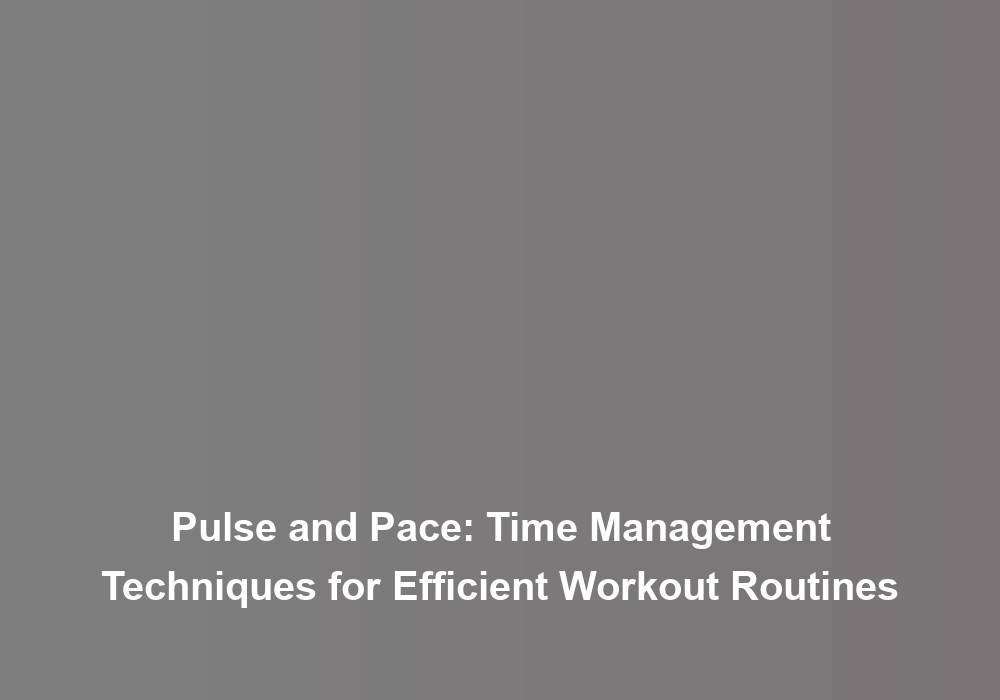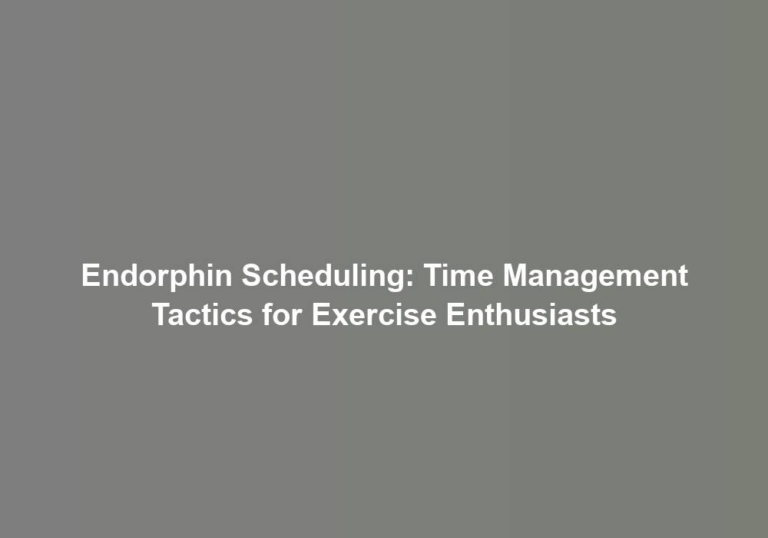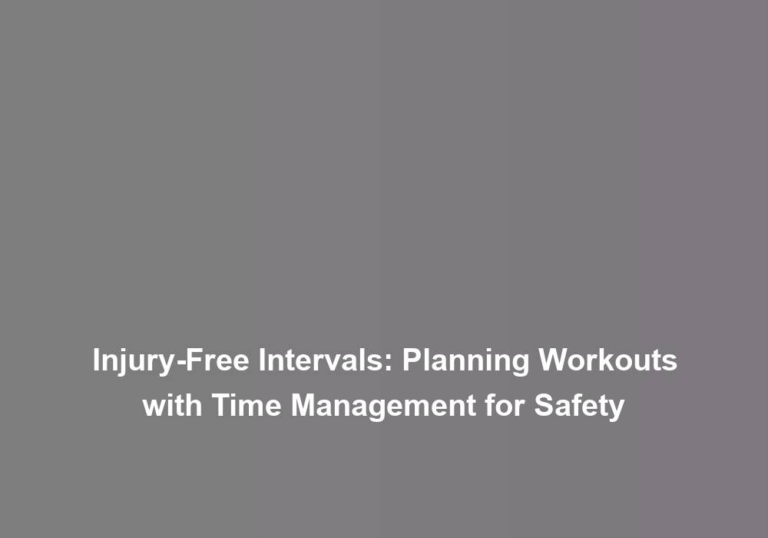Pulse and Pace: Time Management Techniques for Efficient Workout Routines
Feeling like youG??re constantly racing against the clock when it comes to fitting in a workout? ItG??s a common struggle, but there are ways to take control and make the most of your time. By strategically managing your pulse and pace, you can unlock the key to efficient workout routines that fit seamlessly into your busy schedule. With a few simple techniques, youG??ll be able to achieve your fitness goals without sacrificing other important aspects of your life. So, how exactly can you make this work?
Setting Priorities for Your Workouts
To maximize the effectiveness of your workout routine, prioritize exercises that align with your fitness goals and target the specific areas you want to improve. Goal setting is crucial for a successful workout plan. Take a moment to define what you want to achieve. Do you aim to build strength, increase flexibility, or enhance endurance? Setting clear goals will guide your exercise choices and keep you motivated. Once youG??ve established your objectives, task prioritization comes into play. Identify the key exercises that will directly contribute to your goals. If your aim is to build strength, prioritize compound movements like squats, deadlifts, and bench presses. For those focusing on flexibility, prioritize stretching and yoga. If increasing endurance is your goal, prioritize cardiovascular activities such as running, swimming, or cycling. By prioritizing exercises that align with your goals, youG??ll make the most of your workout time and see progress more quickly.
Setting priorities for your workouts doesnG??t mean neglecting other areas. It simply means organizing your routine to optimize your results. Once youG??ve addressed your primary goals, you can incorporate complementary exercises to create a well-rounded workout. This approach ensures that youG??re working towards your goals while also maintaining overall fitness. Remember, itG??s not about doing more, itG??s about doing what matters most to you and your fitness journey.
Streamlining Exercise and Tasks
When streamlining your exercise and tasks, focus on identifying the most efficient ways to achieve your fitness goals while optimizing your time and effort. By integrating multitasking exercises and quick routines into your workout regimen, you can make the most of your limited time and see significant results. Here are some practical strategies to streamline your exercise and tasks:
-
Compound Exercises: Incorporate compound movements into your workouts, such as lunges with bicep curls or squats with shoulder presses. These exercises engage multiple muscle groups simultaneously, maximizing your workout efficiency.
-
Interval Training: Implement high-intensity interval training (HIIT) to condense your workouts while still reaping substantial benefits. HIIT involves alternating between short bursts of intense exercise and brief recovery periods, allowing you to burn more calories and improve your cardiovascular fitness in less time.
-
Circuit Workouts: Create circuits that combine strength training and cardiovascular exercises. This approach not only saves time by eliminating the need for separate workouts but also keeps your heart rate elevated throughout the session, leading to enhanced calorie burn and improved overall fitness.
Efficient Planning for Time Optimization
As you optimize your workout routine by integrating multitasking exercises and quick routines, efficient planning plays a crucial role in maximizing your time and achieving your fitness goals effectively. By implementing time blocking and task batching, you can streamline your workout schedule and make the most out of every exercise session. HereG??s a practical example of how you can plan your workouts more efficiently:
| Time Blocking | Task Batching |
|---|---|
| Schedule specific time slots for different types of workouts, such as cardio, strength training, and flexibility exercises. | Combine exercises that work multiple muscle groups simultaneously, such as lunges with bicep curls or squats with shoulder presses. |
| Allocate time for warm-up, main workout, and cool-down to ensure a well-rounded routine. | Pair exercises that complement each other, like planks with leg lifts or push-ups with mountain climbers. |
| Use a calendar or workout planner to visually organize and allocate time for each workout session throughout the week. | Plan your workout routines in advance, grouping similar exercises together to minimize transitions and maximize efficiency. |
Maximizing Intensity in Short Workouts
Maximize your workout intensity in shorter sessions by incorporating high-intensity interval training and compound exercises for efficient and effective results. When time is limited, itG??s crucial to make every minute count. HereG??s how you can maximize intensity in short workouts:
-
High Impact Exercises: Incorporate high-impact exercises such as burpees, jump squats, and plyometric lunges into your routine. These explosive movements elevate your heart rate and engage multiple muscle groups simultaneously, helping you achieve maximum results in minimal time.
-
Interval Training: Utilize quick circuit workouts that involve alternating between periods of high-intensity exercise and short rest or low-intensity recovery. This approach not only boosts your cardiovascular endurance but also enhances calorie burn both during and after your workout, making it a highly efficient way to achieve your fitness goals.
-
Compound Exercises: Focus on compound movements that work multiple muscle groups at once, such as squats with shoulder presses, lunges with bicep curls, or deadlifts with rows. By combining different exercises into seamless transitions, you can effectively challenge your body and elevate your workout intensity without needing to spend hours at the gym.
Balancing Workout and Life Commitments
To achieve a balance between your workout routine and life commitments, itG??s essential to prioritize and plan your schedule effectively. Achieving work-life balance requires a conscious effort to allocate time for both your personal and professional responsibilities. Start by assessing your current commitments and identifying the non-negotiables. This may include work hours, family time, and other essential tasks. Once you have a clear understanding of these commitments, you can then carve out dedicated time slots for your workouts. Consider integrating physical activity into your daily routine, such as exercising during lunch breaks or waking up earlier for a morning workout. By doing so, you can create a seamless transition between your workout and other life commitments, making it easier to maintain a healthy balance.
Additionally, itG??s crucial to communicate and negotiate with your employer or colleagues to establish boundaries that allow you to prioritize your well-being. Many workplaces are now recognizing the importance of employee wellness and may offer flexible work arrangements to accommodate your workout schedule. DonG??t hesitate to have open discussions about your needs and explore options that support your work-life balance.
Conclusion
YouG??ve got this! Remember, making the most of your time during workouts is key to reaching your fitness goals. Did you know that studies have shown that short, intense workouts can be just as effective as longer ones? So, donG??t be afraid to push yourself and make every minute count. With efficient time management techniques, you can achieve a balanced and fulfilling fitness routine while still managing the demands of everyday life. Keep up the great work!







